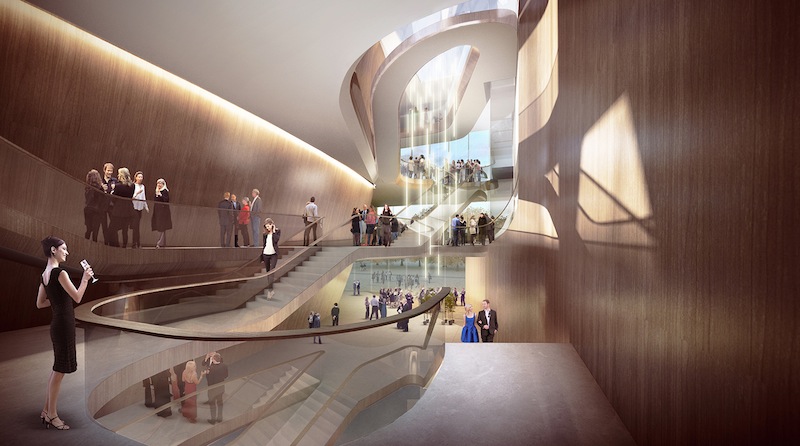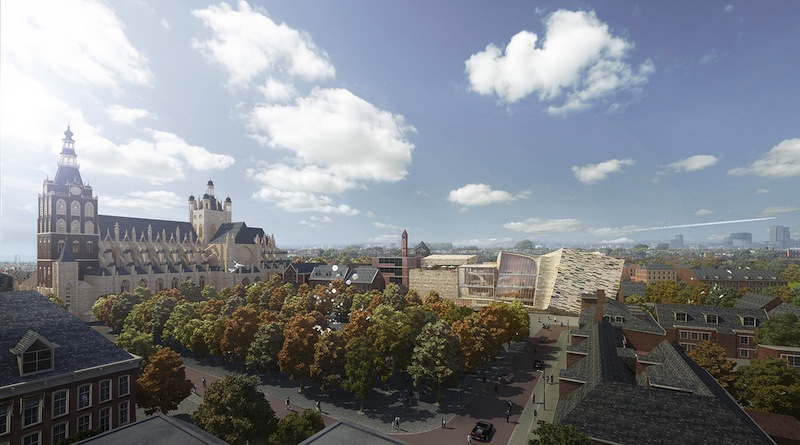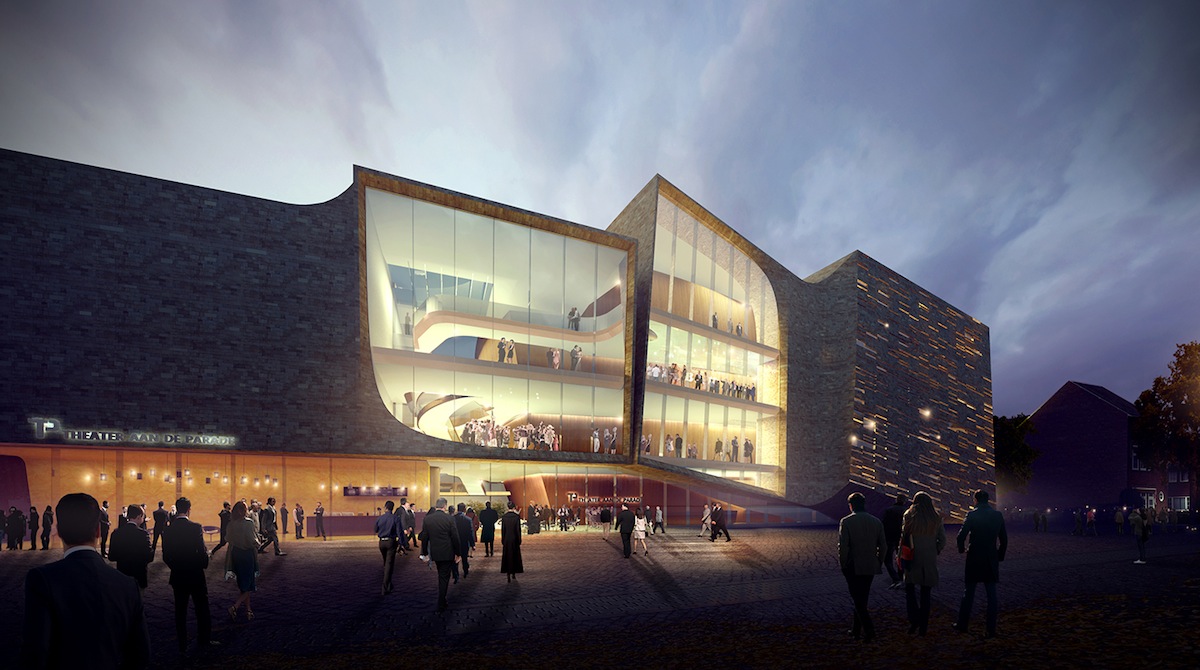Residents of ‘s-Hertogenbosch, a municipality in the southern Netherlands, voted in favor of Amsterdam-based UNStudio’s design proposal for a new theater that will replace an existing, 1970s-era theater in Den Bosch, the colloquial name of this 141,000-person city.
The design, called Theater on the Parade, received 57% of 2,681 votes cast online, beating out Rotterdam-based Ector Hoogstad Architects’ more classical, brick-structured proposal. (The city also surveyed 5,000 residents.) The public’s vote, which was open to all local residents over 12 years old and ran through June 7, counted toward 50% of the municipality’s final decision.
The two finalists had been selected by a panel of judges.
UNStudio’s design for the 10,731-sm (115,500-sf) building integrates the theater’s four separate but connected volumes into its adjacent surroundings, which include a public square and St. John’s Cathedral. ArchDaily reports that the theater’s two auditoriums will feature natural stone facades, while the four-level, 19-meter-high public foyers will be wrapped in glass so the entire building becomes a natural extension of the square. The larger auditorium will be sunken slightly so as not to obscure the sightlines of the cathedral.
“Ideas surrounding sensation and cultural expression form the conceptual basis of the design,” explained Ben van Berkel, Founder and Principal of UNStudio.
Construction is scheduled to begin in 2017, and the project is scheduled for completion by 2020. No cost estimates were released.
The larger auditorium will seat 950 and is designed with walls covered with wooden lamellas for enhanced acoustics. The smaller, 420-seat auditorium, called Paradezaal, will be a flexible space and retractable seating to accommodate different kinds of events.


Related Stories
| Aug 11, 2010
Curtain rises on Broadway's first green theater
The Durst Organization and Bank of America have opened New York's first LEED-certified theater, the 1,055-seat Henry Miller's Theatre. Located inside the new 55-story Bank of America Tower at One Bryant Park, the 50,000-sf theater is located behind the preserved and restored neo-Georgian façade of the original 1918 theater.
| Aug 11, 2010
Restoration gives new life to New Formalism icon
The $30 million upgrade, restoration, and expansion of the Mark Taper Forum in Los Angeles was completed by the team of Rios Clementi Hale Studios (architect), Harley Ellis Devereaux (executive architect/MEP), KPFF (structural engineer), and Taisei Construction (GC). Work on the Welton Becket-designed 1967 complex included an overhaul of the auditorium, lighting, and acoustics.
| Aug 11, 2010
Gold Award: Eisenhower Theater, Washington, D.C.
The Eisenhower Theater in the John F. Kennedy Center for the Performing Arts in Washington, D.C., opened in 1971. By the turn of the century, after three-plus decades of heavy use, the 1,142-seat box-within-a-box playhouse on the Potomac was starting to show its age. Poor lighting and tired, worn finishes created a gloomy atmosphere.
| Aug 11, 2010
Giants 300 University Report
University construction spending is 13% higher than a year ago—mostly for residence halls and infrastructure on public campuses—and is expected to slip less than 5% over the next two years. However, the value of starts dropped about 10% in recent months and will not return to the 2007–08 peak for about two years.
| Aug 11, 2010
Bowing to Tradition
As the home to Harvard's Hasty Pudding Theatricals—the oldest theatrical company in the nation—12 Holyoke Street had its share of opening nights. In April 2002, however, the Faculty of Arts and Sciences decided the 1888 Georgian Revival building no longer met the needs of the company and hired Boston-based architect Leers Weinzapfel Associates to design a more contemporary facility.
| Aug 11, 2010
Team Tames Impossible Site
Rensselaer Polytechnic Institute, the nation's oldest technology university, has long prided itself on its state-of-the-art design and engineering curriculum. Several years ago, to call attention to its equally estimable media and performing arts programs, RPI commissioned British architect Sir Nicholas Grimshaw to design the Curtis R.
| Aug 11, 2010
Silver Award: Hanna Theatre, Cleveland, Ohio
Between February 1921 and November 1922 five theaters opened along a short stretch of Euclid Avenue in downtown Cleveland, all of them presenting silent movies, legitimate theater, and vaudeville. During the Great Depression, several of the theaters in the unofficial “Playhouse Square” converted to movie theaters, but they all fell into a death spiral after World War II.
| Aug 11, 2010
Biograph Theater
Located in Chicago's Lincoln Park neighborhood, Victory Gardens Theater Company has welcomed up-and-coming playwrights for 33 years. In 2004, the company expanded its campus with the purchase of the Biograph Theater for its new main stage. Built in 1914, the theater was one of the city's oldest remaining neighborhood movie houses, and it was part of Chicago's gangster lore: in 1934, John Dillin...
| Aug 11, 2010
Platinum Award: Reviving Oakland's Uptown Showstopper
The story of the Fox Oakland Theater is like that of so many movie palaces of the early 20th century. Built in 1928 based on a Middle Eastern-influenced design by architect Charles Peter Weeks and engineer William Peyton Day, the 3,400-seat cinema flourished until the mid-1960s, when the trend toward smaller multiplex theaters took its toll on the Fox Oakland.







